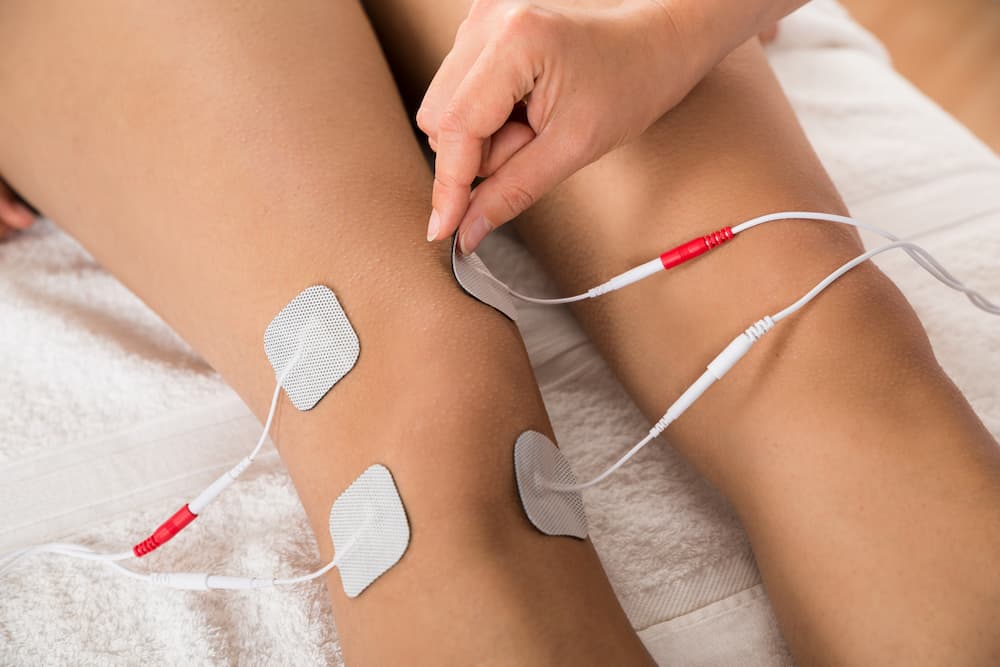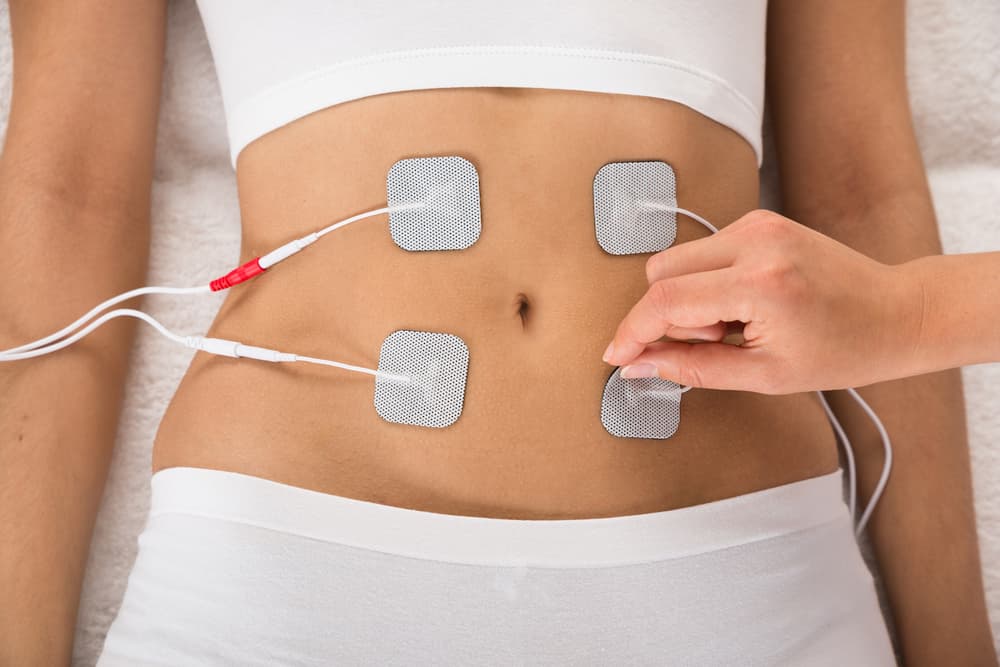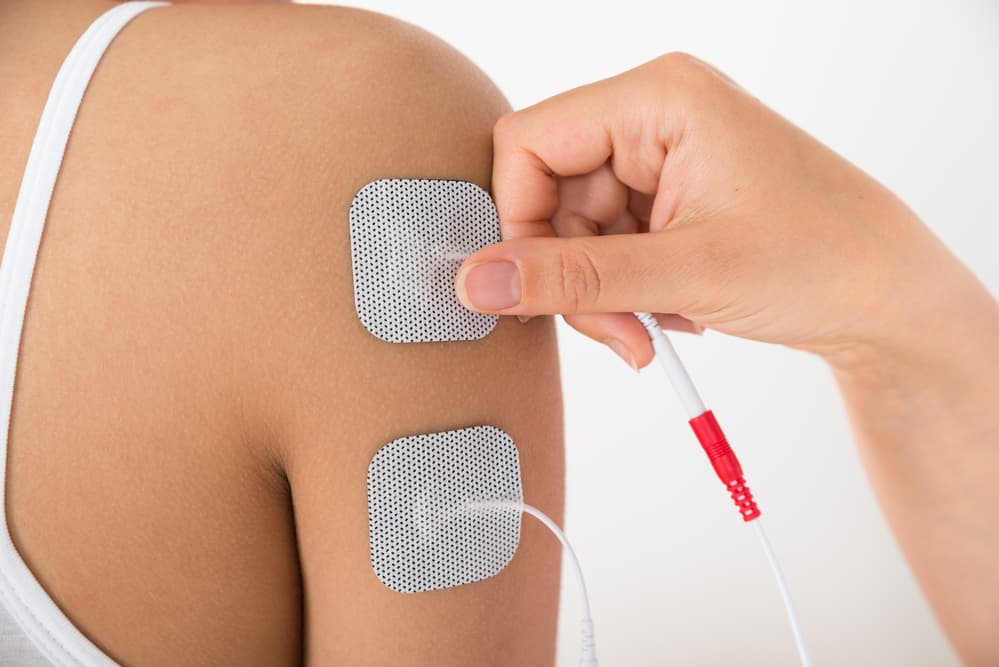You’ve likely come across the ongoing debate on EMS vs TENS regarding which method is superior.
EMS and TENS both use electrical stimulation, but they target different aspects of the body. EMS (electrical muscle stimulation) activates and strengthens muscles to aid in recovery and rehabilitation, while TENS (transcutaneous electrical nerve stimulation) stimulates the nerves to relieve pain.
The best choice depends on the individual’s needs and the specific condition being treated.
In this article, we compare the two methods to help you select the right therapy.
What is EMS or TENS?
Electrical muscle stimulation (EMS) sends low-voltage electrical signals to the muscles via adhesive pads or electrodes.
EMS impulse triggers repeated contractions of the muscles to enhance muscle activation and recovery. Depending on the settings, these can be short, long, frequent, or sustained.
The goal of these muscular contractions varies. It can relieve inflammation or strengthen your muscles without pain or fatigue.
Transcutaneous electrical nerve stimulation (TENS) also transmits electrical impulses via adhesive pads. The target, however, is your nerves, not the muscles.
The purpose of nerve stimulation is to intercept the neurons from sending pain signals to the brain. It results in temporary pain relief but not an absolute cure.
Both EMS and TENS units cause a slight tingling sensation in the body when used. Also, treatment duration can last from a few minutes to less than an hour.

What is the Difference Between EMS and TENS?
The following table summarises the key differences between the two therapies. Keep scrolling for a more in-depth comparison.
| POINT OF COMPARISON | EMS | TENS |
| Mechanism | Sends electrical impulses to muscles, resulting in reduced inflammation and pain | Delivers a low-voltage electrical current to the skin, blocking pain signals and stimulating endorphin release |
| Primary Use | Muscle stimulation and rehabilitation | Pain management, especially for chronic and nerve-related pain |
| Effectiveness | Can improve athletes’ muscle strength, endurance, and flexibility, and may help in muscle recovery after injury or surgery | Can effectively reduce pain at higher intensities and may lessen the need for pain medication |
| Safety | May cause skin irritation from the electrode pads; shock or burning sensations may also occur because of a stronger current; pregnant women and patients with medical implants should consult their doctors first | May cause skin irritation from the electrode pads; pregnant women and patients with medical implants should consult their doctors first |
Mechanism
We now know that EMS targets the muscles, while TENS aims for the nerves. But how do these two forms of electronic stimulation differ?
EMS improves blood circulation. Increased blood flow through muscle stimulation brings many benefits. For instance, it relaxes your muscles, protecting you from inflammation or pain.
Active individuals and athletes require this effect to enhance muscle growth and recovery. It is also beneficial for those with injuries or mobility challenges, as muscle stimulation can help prevent atrophy.
TENS relieves acute and chronic pain. Electrical nerve stimulation can do this by improving your blood circulation. Pain-free impulses from a TENS unit also take over pain signals, resulting in instant relief.
Science further explains this reaction through the gate control theory of pain. Also, stimulating the nerve endings encourages the release of endorphins, our body’s natural painkillers.
Primary Use
One way to settle the TENS machine vs EMS discussion is to understand their purpose or use.
People in fitness centres and rehabilitation clinics, for instance, use EMS units for treating patients who need:
- enhanced blood circulation
- strain-free muscle rebuilding
- muscle cramp or spasm relief
- faster injury or illness recovery
- muscle strengthening or toning
- athletic performance improvement
- muscular relaxation or rehabilitation
- venous thrombosis and muscle atrophy prevention
TENS units are available for home, hospital, or clinical use for pain relief from a range of conditions, like:
- arthritis
- sciatica
- tendonitis
- fibromyalgia
- sports injury
- multiple sclerosis
- headaches or migraines
- carpal tunnel syndrome
- wounds, incisions or surgery
- menstrual, labour, or delivery pain
- back, foot, cancer, or neuropathic pain

Effectiveness
Experts have not yet resolved the debate on the effectiveness of EMS versus TENS.
Researchers must conduct more high-quality studies to prove efficacy. Still, previous results remain promising.
Research from 2012 shows that athletes can use EMS devices as an alternative to traditional strength training. A 2018 study also concluded that EMS is effective for patients who have undergone orthopaedic surgeries.
With TENS, an interesting discovery is the relationship between pain relief and stimulation intensity. A 2014 review showed that patients can develop a tolerance to pain treatment when using the same stimulation level daily.
Thus, researchers from the same study concluded that applying TENS with higher intensity is more effective.
Safety
It’s safe to use both EMS and TENS machines at home. However, they may also cause adverse effects.
Nickel or adhesive allergies may cause skin irritation from the electrode pads in some individuals.
Some also experience shock or burning sensations. These are more common in EMS units, as they transmit a stronger current than TENS.
There are contraindications as well.
For example, EMS and TENS machines may interfere with pacemakers and defibrillators. Patients with these medical device implants should then consult their doctors first.
It is still unclear how EMS and TENS can affect unborn babies, too. So, if you are pregnant, be sure to talk to your midwife or healthcare provider before using electrotherapy.

EMS vs TENS Unit: Verdict
In conclusion, both devices have similar approaches to stimulation, safety, and contraindications.
EMS and TENS units primarily differ in their targets for stimulation. Identifying your goal for electrotherapy is crucial in selecting a suitable device and achieving optimal results.
- For pain relief, TENS is often the preferred choice, especially for chronic or nerve-related pain.
- For muscle strengthening and recovery, EMS is a more suitable option.
- For both pain and muscle issues, a combination TENS/EMS unit may be the most beneficial.
Some devices offer both TENS and EMS functionalities, allowing for a more versatile approach to managing both pain and muscle-related issues.
If you are this type of user, you can check out my EMS TENS machine buying guide and review and learn more. Remember to consult with a healthcare professional to determine the most appropriate therapy for your individual needs and condition.
Related Questions
1. Is it OK to use EMS every day?
Using EMS every day is not advisable. Most experts suggest using EMS 2-3 times per week to allow for adequate muscle recovery. Daily use may increase the risk of injury.
2. Is EMS stronger than TENS?
EMS provides a stronger electrical impulse than TENS, designed to stimulate muscle fibres for contraction and muscle strengthening. In contrast, TENS devices apply a lower current and different frequency to stimulate nerves.
- What Are the Best Exercises on a Trampoline for Weight Loss? - 17 December 2025
- How Does Sleep Quality Impact Muscle Recovery and Fitness Progress? - 16 December 2025
- How Can You Eat Healthy with a Busy Schedule? - 15 December 2025
